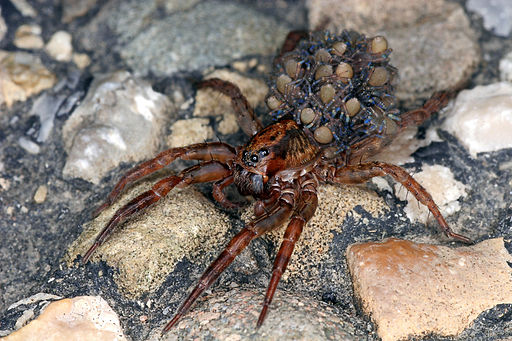SERVICE REQUEST?
Fill out the form below.
Find our nearest location
Your Local Office

Wolf Spider
Attribution: Valerius Geng, [GFDL or CC-BY-SA-3.0-2.5-2.0-1.0], via Wikimedia Commons
Size:
Wolf spiders come in many sizes with most having a body size ranging from 1/4-inch to more than 1 1/2 inches in length. The largest species may have a leg measuring up to 3 inches or more leading many homeowners to mistake them for tarantulas.
Color:
Most wolf spiders are brown although some may appear black.
Behavior:
Wolf spiders are active hunters which search for prey during the day or night, depending on the species. These common spiders may live in significant numbers around homes and other buildings, especially those structures which have lush landscaping. Wolf spiders enter underneath doors or through cracks in the exterior walls. Wolf spiders are unique in that they carry their egg sacs from the tip of their abdomens attached to the spinnerets. The young spiderlings also ride on the mother’s back for a few days after hatching. Bites involving wolf spiders are rare and are not dangerous.
Outdoors, wolf spiders occupy a wide variety of habitats, usually at ground level. They will be common in heavy ground covers, such as ivy or monkey grass, and can be found beneath stones and other items, as well as within cracks between landscape timbers. They do not breed in homes, and usually only one to a few will be seen inside.
The best approach for controlling wolf spiders is through placement of sticky traps to capture the few spiders that may have entered. Maintaining sticky traps behind furniture, to either side of exterior doors, and in the garage is an excellent way to intercept most spiders as they enter. Steps that should be taken to prevent new spiders from entering, include:
- Removing or limiting heavy, ground-covering vegetation near the building.
- Sealing cracks and holes in the building’s exterior.
- Installing tight-fitting screens on all attic and foundation vents.
- Sealing holes around pipes indoors to prevent spiders from entering the living spaces by following plumbing lines in basements and crawl spaces.
Where wolf spider invasions are persistent, a professional should be consulted to conduct a thorough inspection and recommend possible treatments.
Family Name:
Family Lycosidae
Read What Our Clients
Are Saying
My Terminix tech Scott is the best! He is professional, courteous and absolutely thorough about his job. Thank you for sending such a blessed tech to my house. Hamlet, NC
This letter is to say how pleased we are here at Morreene West Apartments with your services. We are very pleased with the technician, Christopher. He does a great job. Durham, NC
Terminix has consistently offered our apartment complex reliable, competent service. We are completely satisfied with their knowledgeable representative who is always punctual and does a superior job for us every time. Chapel Hill, NC
I would like to take the time to thank you for giving us such great service here at Carver Pond Apartments. Your Pest Technician Christopher Mitchell has provided us with excellent service over the last few months. Christopher is such a great help to us in providing helpful information so that we can better serve our residents here at Carver Pond. Durham, NC
SERVICE REQUEST?
Fill out the form below.